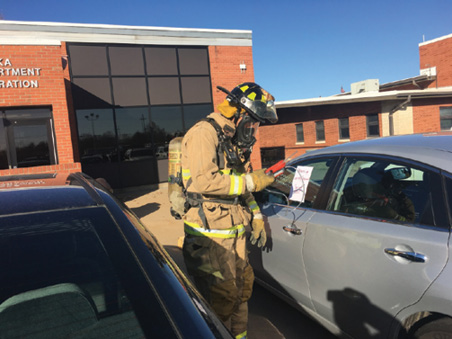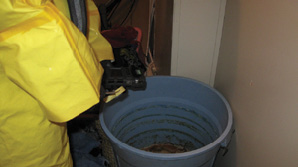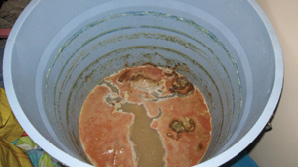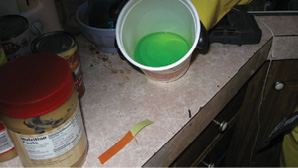
By PHIL AMBROSE
Scenario: The tones drop for a train derailment. Firefighters don their gear, mount their rigs, and head to the scene. On arrival, they find four tanker cars on their sides oozing gallons upon gallons of ethyl-methyl “bad stuff.” The responders’ next actions are pretty straightforward: pull back to a safe distance and get hazmat experts en route to the scene. This is a “once in a career” call for most firefighters.
However, the more likely scenario goes like this: The tones drop for a structure fire with smoke showing, and firefighters don their turnouts, eager to get to the scene. On their arrival, the house shows heavy smoke conditions with possible victims inside. Without hesitation, responders stretch lines and “mask up” to make entry into the hazardous environment to search for survivors.
Despite the obvious hazardous materials, pulling back and calling for hazmat can’t be found in the crew’s incident action plan, and rightly so; when there is a possible victim to rescue, firefighters swing the risk-vs.-gain decision heavily toward entering the toxic atmosphere.
A working fire is a hazmat scene that features modern products of combustion that are highly toxic and contain numerous chemicals. This environment can be extremely challenging because of heat, low visibility, and fire conditions; it’s an environment that is likely to get worse before it gets better. Yet, firefighters quickly assess the conditions and victim survivability and make entry, confident their self-contained breathing apparatus (SCBA) will give fresh breathing air in an immediately dangerous to life or health (IDLH) environment.

(1) Firefighters approach a suspected chemical suicide vehicle in turnout gear and SCBA while also monitoring the air. (Photos courtesy of Jason Rogers, HazSim Training.)
A New Scenario
In 2015, a California man’s roommate called 911 because he smelled chemicals and found a suicide note in their apartment. News reports said a hazmat team found the man barricaded inside the bathroom. By the time they entered, the man was deceased next to two barbecue grills. The victim intentionally created a lethal environment by filling close quarters with carbon monoxide from the grills.
If the roommate had smelled smoke and reported a fire, the responders would have likely masked up and made entry. By comparison, the second scenario of a “routine” room-and-contents fire will produce deadly conditions with many more chemicals than those found in the first suicide scenario. This begs the question: Was it the right call to wait for the hazmat team? When smoke is showing, we go in; but when chemicals may be present, why do we often stage for the hazmat team? Firefighters are faced with hazardous materials at every structure and vehicle fire, but many have been trained to stage for hazmat teams when there’s even a small possibility that hazardous materials are present.
There is clearly a “gray area” when first responders are faced with a rescue in a potential chemical environment. For example, in late 2015, law enforcement and emergency medical services (EMS) responded to a routine call to check on the welfare of an individual after an early-morning call from a concerned family member. On arrival, the law enforcement officers were overwhelmed by noxious fumes, forcing them back out of the doorway. EMS was staged pending hazardous materials response units. Quick-thinking firefighters donned their SCBA and went in for the grab. They brought the victim out of the hazardous environment and into fresh air. Both firefighters were unhurt. If all units continued to stage for a hazmat team, this may not have been a save.

(2) Turnout gear and SCBA offer firefighters ample protection for recon and potential rescue.
For many responders, calls for a suicidal person are becoming more the norm than the exception. Ingestion, hanging, laying across train tracks, electricity, and weapons are common methods people employ to end their lives. My neighboring agency has trained a team to deploy an air bag at their local bridge, which is famous for jumpers. When weapons are involved, we correctly stage for obvious reasons and defer to law enforcement experts. However, should we be as cautious with chemicals as we are with weapons? This is an important question because as the number of calls for suicidal individuals grow, so, too, does the choice of chemicals as a means of death. The answer to this question is yes—we must exercise caution, but we don’t always have to wait for hazmat experts.








(3-10) Scene photos from a suicide attempt in Gaston, Indiana, where a man attempted to kill himself with a mixture of chemicals.
One reason for the spike in chemical suicide attempts is the ease with which people can learn how to do it. Before the Internet, I responded to calls for a vehicle running in a garage. Carbon monoxide in the vehicle’s exhaust and the confined area created a toxic environment intended to kill the victim. When called to these incidents, we opened the garage and used SCBA to perform rescue. The hazmat team was not involved.
At worst, an attempted rescue is like a good reconnaissance mission. In 2016, a San Diego County, California, individual prepped for a chemical suicide by placing warning signs on the front door. When first responders arrived, they found the signs and called for a hazmat team. When the special operations team made entry, they found the victim in bed overdosed on sleeping pills before he could finish preparing the chemical concoction meant to end his life. Firefighters in SCBA could have come to this conclusion without waiting for a hazmat team and thus allowed for faster EMS intervention.
Five Key Considerations
Following are five key considerations firefighters must remember when confronted with victims in a hazmat environment.
Ventilation. For a chemical suicide to be fatal, it must be done in a confined environment. An enclosed area will increase the toxic concentration just as a garage with a vehicle running would need to be closed to kill the victim. Ventilation immediately reduces the concentration of lethal toxins just as it does for structure fires. Breaking a window, forcing a door, using a fan, or quickly removing the victim from the enclosed area could change the outcome immediately.
Respiratory protection. Chemical suicides are performed with various mixtures of chemicals or, in the examples above, by a burning barbecue grill or running a car in an enclosed space (which creates a steady supply of carbon monoxide). In all cases, the source may be limited. A chemical gas—the reaction of the mixed chemicals—is limited to the amount of chemicals used relative to the size of the confined space. In each case, an SCBA provides ample respiratory protection to perform a rescue.
Exposure protection. A gas prefers to remain a gas and generally will not linger and stay on a victim. The chemicals used to create the gas (often in a bucket) could pose a contamination risk if they are directly contacted. Firefighter turnouts do not provide chemical-contact protection for most of the chemicals used in a chemical-mixture suicide.
So, why do I say it is okay to make entry? Because we are considering a rescue to save a human life. Just as our structural firefighter turnouts are not fireproof, we can and do go into an IDLH fire condition to perform fire suppression and rescues. As the only option for fast action, firefighter turnouts with SCBA are sufficient to make a quick grab of a victim and remove him to a better environment.
Decontamination. Fire companies typically have an abundance of water and should perform a hasty gross decontamination of victims and rescuers. As with any industrial chemical exposure call, removing clothing will remove large amounts of contaminants. If the victim was only exposed to gas, decontamination should be easy. If there was further exposure, a good wash prior to transport is required so you do not bring contaminants to the hospital. Likewise, give firefighter personal protective equipment (PPE) an on-scene gross decontamination and remove and bag them if they directly contacted the chemical; this will keep crews from carrying the contaminants into the rig and back to the fire station.
Preincident plan, postincident assessment. This may be the most important takeaway. One thing that is true across all emergency response disciplines is that a good outcome depends on a good plan and good training. And, a good plan depends on a good assessment of past incidents. Fire departments are good at planning for active-shooter events, high-rise evacuations, and church or strip mall fires. They are also very good at doing postmortem analysis—dissecting what went right and what went wrong—of every fire they run. Those same “what if” conversations need to happen when it comes to hazmat incidents with a potential save. Lay out a formal plan for when the “man slumped over in a car” welfare check call turns out to be an attempted chemical suicide. Each department will have different solutions: Some may dispatch engine or truck companies to certain calls where suicide is likely, while some may equip ambulances with PPE and forcible entry tools.
Regardless of the individual solution, research similar past calls and examine case studies from other jurisdictions as you would when creating, for instance, an active-shooter plan. When responders are injured at such calls, it is often because they were not fully informed and equipped to handle the emergency.
When responders are injured en route to chemical suicide incidents, it is because they believed they were dispatched to an EMS run. One such case happened on June 11, 2015, in Lowell, Massachusetts, which left one man dead and four police officers and three EMS workers hospitalized with respiratory issues. The responders did not have immediate access to SCBA and did not call hazmat experts prior to being exposed. The first-in company to a drug lab or chemical suicide may not be wearing firefighting PPE, may not have clues to follow such as smoke showing, and will not be a hazmat team. Injuries occur when the responders are unprotected in a chemical environment.
Not every tone for a hazmat call will present a churning green cloud the size of Madison Square Garden. And, not every tone out will require a Three Mile Island level of hazmat response. It is critical for firefighters and officers to learn the signs of hazmat situations, and they must have a plan to back out and call for resources (yes, the hazmat team). However, to save more civilian lives, that plan must involve knowing how and when to deploy firefighters in full PPE and SCBA and how to ventilate.
PHIL AMBROSE is a 16-year member of the Glendale (CA) Fire Department, where he serves as a captain, a paramedic, and a hazmat specialist. Additionally, he spent eight years as a hazmat expert with UCLA. He founded the company HazSim in 2011. Ambrose also earned the Federal Bureau of Investigation’s Exceptional Public Service Award for his work on its hazardous materials response team. He presented a class on hazmat at FDIC International 2017 and will do so again at FDIC International 2018.

